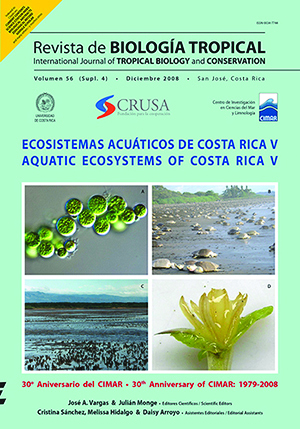Abstract
Factors affecting the La Estrella river basin and recommendations for environmental management of its coastal area (Caribbean of Costa Rica). Coastal areas are heavily influenced by river basins in their vicinity. Coastal and watershed management requires an integrated approach. Several factors should be considered. Among them: water quality, silt, erosion, land use, forest cover, legislation, and human impact. The coral reef at Cahuita National Park and the surrounding communities are of great value in biological, economical and ethnical grounds. La Estrella river basin seems to play a key role affecting this coastal area. Potential factors for erosion were determined in the basin and several parameters of water quality were analyzed, placing emphasis on the silt discharge at six stations along the main river and on six of its tributaries. The stations were selected along a gradient representing different natural conditions and levels of human inpact. We sampled silts from September to December 2003 and from January to May 2004, at approximately 22 day intervals. In each occasion, three water samples (a liter each) were taken per sampling site in a traverse section of the river. In the main river bed, the Vesta station (higher altitude, larger forest cover, bigger percentage of protected area and less human impact) presented the smallest silt discharges (close to 9 000g/s in a rainy day). Meanwhile, the stations of Bonifacio and Pandora (lowlands, lesser forest cover and higher intensity of land use) presented the largest discharges (around 16 000g/s in a rainy day). For the tributaries, the stations at river Hitoy Cerere (biological reserve) and river Bitey (the smallest basin) contributed the lowest silt values. The stations at the other tributaries (characterized by less forest and less protected area) presented the largest values. About 25% of the basin soils were over-used. We also found large patches of land with no forest cover, in protected areas, or in areas where some sort of forest management or natural restoration were supposed to take place. The generalized absence of riparian forests in the low basin was the norm. These results show a severe lack of environmental law enforcement. The residents of La Estrella River Valley have the perception that deforestation exists due to illegal pruning and that there is significant pollution from solid waste, pesticides, and served and soapy waters. They have little knowledge of the coral ecosystem associated with the river. Law enforcement and education are strongly needed in the area. Rev. Biol. Trop. 56 (Suppl. 4): 191-203. Epub 2009 June 30.References
Cortés, J. & M.J. Risk. 1984. El arrecife coralino del Parque Nacional de Cahuita, Costa Rica. Rev. Biol. Trop. 32: 109-121.
Cortés, J. 1981. The Coral Reef at Cahuita, Costa Rica: A Reef Under Stress. M.Sc. Thesis, McMaster University, Hamilton, Canadá.
Feoli, S. 1987. Geología de la quebrada Kitadikur y alrededores del Valle de la Estrella, provincia de Limón, Costa Rica. Campaña geológica G-5216, Universidad de Costa Rica, San José, Costa Rica.
Fondo Nacional de Financiamiento Forestal (FONAFIFO). 2004. Manual de procedimientos para el Pago de Servicios Ambientales. San José, Costa Rica.
Goreau, T. & N. Goreau. 1979. Corales y arrecifes coralinos: los diminutos pólipos de los corales, que viven en simbiosis con algas fotosintéticas. Inv. Cien. 37: 45–60.
ICE. 1987. Boletín de calidad fisico-químico del agua N°2. Departamento de Planificación Eléctrica, Oficina de Hidrología, Instituto Costarricense de Electricidad, San José, Costa Rica.
IJSA. 2002. Ley de aguas y ley general de agua potable. Investigaciones Jurídicas S.A. San José, Costa Rica.
IJSA. 1999. Ley Forestal y su reglamento: Anotaciones sobre acciones de inconstitucionalidad. Investigaciones Jurídicas S.A, San José, Costa Rica.
Instituto Nacional de Estadística y Censos. 2002. IX Censo Nacional de Población: Características Sociales y Demográficas, p. 274, cuadro 27, San José, Costa Rica.
ITCR. 2000. Atlas Costa Rica 2000. Laboratorio de Sistemas de Información Geográfica, Escuela de Ingeniería Forestal, Instituto Tecnológico de Costa Rica, Cartago, Costa Rica.
ITCR. 2004. Atlas Costa Rica 2004. Laboratorio de Sistemas de Información Geográfica, Escuela de Ingeniería Forestal, Instituto Tecnológico de Costa Rica, Cartago, Costa Rica.
MAG & MIRENEN. 1994. Mapa de capacidad de uso de las tierras: clases forestales. Fundación Neotrópica, San José, Costa Rica.
Mata, A & O. Blanco. 1994. La Cuenca del Golfo de Nicoya: un reto al desarrollo sostenible. Universidad de Costa Rica, San José, Costa Rica.
Mora, I. 1987. Evaluación de la pérdida de suelo mediante la ecuación universal (EUPS): aplicación para definir acciones de manejo en la cuenca del río Pejibaye, Vertiente Atlántica, Costa Rica. Tesis de Maestría, Centro Agronómico Tropical de Investigación y Enseñanza, Turrialba, Costa Rica.
Naiman, R. & R. Bilby. 1998. River ecology and management: lessons from the Pacific coastal ecoregion. Springer, Nueva York, EEUU.
Organización Mundial de la Salud. 1987. Guías para la calidad del agua potable: criterios relativos a la salud y otra información base. Washington DC, EEUU.
Palmer, P. 1994. “Wa’ apin man”: la historia de la costa talamanqueña de Costa Rica, según sus protagonistas. Universidad de Costa Rica, San José, Costa Rica.
Pérez, G. 2004. Evaluación de la calidad de las aguas de drenaje del sector de riego de Tamarindo para el manejo de humedales en el Parque Nacional Palo Verde. Tesis de Maestría, Universidad de Costa Rica, San José, Costa Rica.
Roldán, G. 1992. Fundamentos de limnología neotropical. Antioquia, Medellín, Colombia.
Sawyer, C., L. McCarty & F. Parkin. 2001. Química para ingeniería ambiental. McGraw Hill, Bogotá, Colombia.
Skoog, D., D. West, F. Holler & S. Crouch. 2001. Química analítica. McGraw-Hill, México DF, Mexico.
Tomascik, T. 1992. Enviromental management guidelines for coral reef ecosystems. State Ministry for Population and Enviromental, Jakarta.
Centro Centroamericano de Población. 2004. Infocensos. Universidad de Costa Rica, San José, Costa Rica. (Consultado: 19 julio 2004, www.infocensos.ccp. ucr.ac.cr)
##plugins.facebook.comentarios##

This work is licensed under a Creative Commons Attribution 4.0 International License.
Copyright (c) 2008 Revista de Biología Tropical






